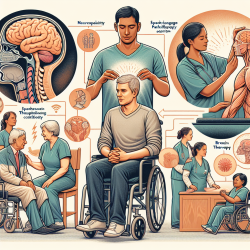Introduction to Combined Therapeutic Approaches
In the realm of neurological rehabilitation, the complexity of functional recovery necessitates innovative approaches. The recent research article, "Editorial: Combined Therapeutic Approaches to Neurological Rehabilitation," published in Frontiers in Rehabilitation Sciences, underscores the potential of integrating various therapeutic modalities to enhance rehabilitation outcomes. This blog aims to guide practitioners in implementing these findings to improve their practice and encourage further exploration in this promising area.
Understanding the Research
The research emphasizes the importance of combining neurophysiological, behavioral, and pharmacological interventions to address cognitive, motor, and communication outcomes. By leveraging the concept of neuroplasticity, these multi-component interventions aim to maximize rehabilitation outcomes across various neurological populations and functional domains.
Key Findings and Implications
Several themes emerge from the research, highlighting the potential benefits of combined therapeutic approaches:
- Brain Stimulation and Cognitive/Motor Treatments: Studies suggest that combining brain stimulation techniques, such as repetitive transcranial magnetic stimulation (rTMS), with cognitive or motor treatments can improve outcomes. For instance, Pastore-Wapp et al. hypothesize that combining rTMS with video-game-based skill training may enhance dexterity in Parkinson's disease patients.
- Interactive Technologies in Rehabilitation: The use of interactive technologies, such as electromyography and visual feedback training, has shown promise in improving rehabilitation outcomes. Volk et al. demonstrated that such technologies could reduce synkinesis in patients with postparalytic facial synkinesis.
- Combinatorial Interventions Based on Functional Networks: Studies like Vangilder et al.'s secondary analysis highlight the relationship between cognitive and motor deficits in recovery, suggesting that targeting coherent functional networks can lead to improved performance.
- Pharmacological and Physical Therapy Integration: Plummer et al.'s study combining dalfampridine with physical therapy indicates that such integration can enhance walking function in multiple sclerosis patients.
Practical Applications for Practitioners
Practitioners can enhance their therapeutic approaches by incorporating the following strategies:
- Embrace Multidisciplinary Collaboration: Collaborate with professionals from various disciplines to design comprehensive treatment plans that address multiple aspects of a patient's condition.
- Utilize Technology: Integrate interactive technologies and brain stimulation techniques to enhance traditional therapeutic methods.
- Focus on Personalized Treatment: Tailor interventions based on individual patient needs, considering cognitive, motor, and communication deficits.
- Stay Informed: Keep abreast of the latest research and developments in combined therapeutic approaches to continually refine and improve treatment strategies.
Encouraging Further Research
While the current research provides valuable insights, it also highlights the need for further exploration. Practitioners are encouraged to engage in research activities, contribute to the growing body of knowledge, and explore new combinations of therapeutic modalities to enhance rehabilitation outcomes.
To read the original research paper, please follow this link: Editorial: Combined Therapeutic Approaches to Neurological Rehabilitation.










